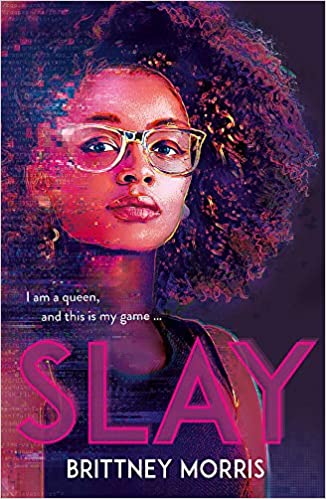
Price: £7.99
Publisher: Hodder Children's Books
Genre: Fiction
Age Range: 14+ Secondary/Adult
Length: 352pp
Buy the Book
Slay
‘By day, I’m an honours student at Jefferson Academy. At night, I turn into the Nubian goddess most people know as Emerald.’ The speaker of the novel’s opening lines is seventeen-year-old Kiera Johnson. She and her sister Steph are the only two Black girls at the Academy in Bellevue, Washington State. Kiera and her long-term boyfriend, Malcolm, transferred to Jefferson from Belmont, where 50% of the students were Black. Malcolm’s transfer was not voluntary – his lip still carries the scar from the fight that got him expelled from Belmont. Kiera’s doing well academically, has several college offers already and she and Malcolm plan to share a life in Atlanta during their college years, though they expect to enrol at different universities. Her Nubian night-time persona inhabits the hugely successful VR gaming world of SLAY, with half-a-million account holders worldwide. Even Steph, her parents, and her best friend Harper don’t know that for three years Kiera has been developing Emerald’s universe in partnership with ‘Cicada’, who lives in Paris. Kiera doesn’t know Cicada’s real life name – the two have never met outside SLAY.
At the core of Brittney Morris’s novel, driving the story, there is a dilemma. SLAY is designed to be exclusively for Black gamers. When Kiera speaks within the game as Emerald, she says, “We are here first and foremost to celebrate Black excellence in all its forms, from all parts of the globe.” That’s the principle on which Kiera developed SLAY; the game is for Black players only. No Whites allowed, and herein lies the conflict and, maybe, the catastrophe which challenges the game and Kiera herself. SLAY hits the international media when a teenager is murdered in Kansas City over an argument (concerning SLAY’s trading currency) arising within the game. Suddenly the media is all over Kiera’s project. Ethics Professors are invited onto TV chat shows to talk about whether excluding Whites is racist and, as the murder may demonstrate, dangerously discriminatory. Both of Kiera’s worlds explode into controversy and publicity. Before long, she is personally under threat from a troll.
I need here to step away from any attempt to reflect the narrative closely. The story is very tightly plotted – argued, even; which is remarkable in that Hodder’s blurb tells us that Morris wrote this 318 page book in eleven days. I couldn’t do the storyline justice in this reviewing space. In fact, I began to wonder, can I do the novel justice at all? You could say that implied readers of SLAY need to be sensitive to nuanced discussion of contemporary Afro-American matters – particularly in the experience of young people. Also, readers would surely take more from the text if they are familiar with VR Gaming, though a novice (such as myself) can learn something from the blow-by-blow accounts of duels in the SLAY world, where duelling is the main purpose of playing.
My own reviewing position here seems problematic, at least to me. Since the 1970s, many teachers and others interested in literature for young readers thought increasingly in terms of ‘what a reader brings to a book’ interplaying with what a book offers to a reader. (Subsequently, the National Curriculum, with its inappropriate need to measure and assess responses to literature, inhibited such an awareness when teaching literature.) Here, what I bring to this novel includes areas of ignorance, which do not limit my interest, but do raise concerns about fairness to the author in reaching any detailed evaluation of it. The questions SLAY raises are complex and difficult to resolve; and – to be just a little evaluative – embodied in an unconventional and arresting narrative. One aspect of the novel may serve as an example: for me, some of the duelling sequences were overlong – too detailed; perhaps we are used to the graphic speed of the visual in handling such action. Yet, as soon as I write that, I am unsure that I have a sense of how young readers used to gaming would judge those duels.
In this instance, the five stars at the head of this review are meant to indicate a strong recommendation that readers should try this unusual and passionate book. For its own sake – and also as a novel which (as far as I know) will take UK readers into areas they are unused to finding in print.




